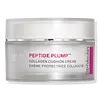What's inside
What's inside
 Key Ingredients
Key Ingredients

No key ingredients
 Benefits
Benefits

 Concerns
Concerns

 Ingredients Side-by-side
Ingredients Side-by-side

Water
Skin ConditioningPropanediol
SolventIsodecyl Neopentanoate
EmollientGlycerin
HumectantSorbitan Laurate
EmulsifyingIsocetyl Stearoyl Stearate
EmollientBis-Stearyl Dimethicone
EmollientBetaine
HumectantDimethicone
EmollientSucrose
HumectantMyristyl Nicotinate
Skin ConditioningSoluble Proteoglycan
Skin ConditioningAcetyl Hexapeptide-8
HumectantPentapeptide-76 Amide
Hydrolyzed Rhodophyceae Extract
Lens Esculenta Fruit Extract
Skin ConditioningHydrolyzed Hyaluronic Acid
HumectantLycium Barbarum Fruit Extract
AstringentPyrus Malus Fruit Extract
Skin ConditioningCitrullus Lanatus Fruit Extract
Skin ConditioningCrambe Abyssinica Seed Oil
Skin ConditioningBeta-Glucan
Skin ConditioningBacillus/Sea Salt Ferment Filtrate
Skin ConditioningSqualane
EmollientAdenosine
Skin ConditioningLactic Acid
BufferingPotassium Cetyl Phosphate
Emulsifying1,2-Hexanediol
Skin ConditioningSodium Polyacrylate
AbsorbentCetyl Hydroxyethylcellulose
Emulsion StabilisingHydrogenated Polydecene
EmollientButylene Glycol
HumectantPotassium Lactate
BufferingCaprylhydroxamic Acid
Pentylene Glycol
Skin ConditioningTrideceth-6
EmulsifyingCaprylyl Glycol
EmollientSodium Lactate
BufferingPotassium Sorbate
PreservativeSodium PCA
HumectantSodium Benzoate
MaskingLimonene
PerfumingCI 17200
Cosmetic ColorantParfum
MaskingWater, Propanediol, Isodecyl Neopentanoate, Glycerin, Sorbitan Laurate, Isocetyl Stearoyl Stearate, Bis-Stearyl Dimethicone, Betaine, Dimethicone, Sucrose, Myristyl Nicotinate, Soluble Proteoglycan, Acetyl Hexapeptide-8, Pentapeptide-76 Amide, Hydrolyzed Rhodophyceae Extract, Lens Esculenta Fruit Extract, Hydrolyzed Hyaluronic Acid, Lycium Barbarum Fruit Extract, Pyrus Malus Fruit Extract, Citrullus Lanatus Fruit Extract, Crambe Abyssinica Seed Oil, Beta-Glucan, Bacillus/Sea Salt Ferment Filtrate, Squalane, Adenosine, Lactic Acid, Potassium Cetyl Phosphate, 1,2-Hexanediol, Sodium Polyacrylate, Cetyl Hydroxyethylcellulose, Hydrogenated Polydecene, Butylene Glycol, Potassium Lactate, Caprylhydroxamic Acid, Pentylene Glycol, Trideceth-6, Caprylyl Glycol, Sodium Lactate, Potassium Sorbate, Sodium PCA, Sodium Benzoate, Limonene, CI 17200, Parfum
 Reviews
Reviews

Ingredients Explained
These ingredients are found in both products.
Ingredients higher up in an ingredient list are typically present in a larger amount.
Glycerin is already naturally found in your skin. It helps moisturize and protect your skin.
A study from 2016 found glycerin to be more effective as a humectant than AHAs and hyaluronic acid.
As a humectant, it helps the skin stay hydrated by pulling moisture to your skin. The low molecular weight of glycerin allows it to pull moisture into the deeper layers of your skin.
Hydrated skin improves your skin barrier; Your skin barrier helps protect against irritants and bacteria.
Glycerin has also been found to have antimicrobial and antiviral properties. Due to these properties, glycerin is often used in wound and burn treatments.
In cosmetics, glycerin is usually derived from plants such as soybean or palm. However, it can also be sourced from animals, such as tallow or animal fat.
This ingredient is organic, colorless, odorless, and non-toxic.
Glycerin is the name for this ingredient in American English. British English uses Glycerol/Glycerine.
Learn more about GlycerinParfum is a catch-all term for an ingredient or more that is used to give a scent to products.
Also called "fragrance", this ingredient can be a blend of hundreds of chemicals or plant oils. This means every product with "fragrance" or "parfum" in the ingredients list is a different mixture.
For instance, Habanolide is a proprietary trade name for a specific aroma chemical. When used as a fragrance ingredient in cosmetics, most aroma chemicals fall under the broad labeling category of “FRAGRANCE” or “PARFUM” according to EU and US regulations.
The term 'parfum' or 'fragrance' is not regulated in many countries. In many cases, it is up to the brand to define this term.
For instance, many brands choose to label themselves as "fragrance-free" because they are not using synthetic fragrances. However, their products may still contain ingredients such as essential oils that are considered a fragrance by INCI standards.
One example is Calendula flower extract. Calendula is an essential oil that still imparts a scent or 'fragrance'.
Depending on the blend, the ingredients in the mixture can cause allergies and sensitivities on the skin. Some ingredients that are known EU allergens include linalool and citronellol.
Parfum can also be used to mask or cover an unpleasant scent.
The bottom line is: not all fragrances/parfum/ingredients are created equally. If you are worried about fragrances, we recommend taking a closer look at an ingredient. And of course, we always recommend speaking with a professional.
Learn more about ParfumWater. It's the most common cosmetic ingredient of all. You'll usually see it at the top of ingredient lists, meaning that it makes up the largest part of the product.
So why is it so popular? Water most often acts as a solvent - this means that it helps dissolve other ingredients into the formulation.
You'll also recognize water as that liquid we all need to stay alive. If you see this, drink a glass of water. Stay hydrated!
Learn more about Water